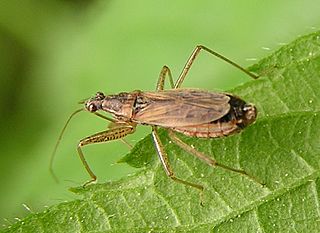
Pentatomidae is a family of insects belonging to the order Hemiptera, generally called shield bugs or stink bugs. Pentatomidae is the largest family in the superfamily Pentatomoidea, and contains around 900 genera and over 4700 species. As hemipterans, the pentatomids have piercing sucking mouthparts, and most are phytophagous, including several species which are severe pests on agricultural crops. However, some species, particularly in the subfamily Asopinae, are predatory and may be considered beneficial.

Nabis is a genus of damsel bugs in the family Nabidae.

Platymeris is a genus of assassin bug (Reduviidae). Platymeris species are often used in laboratories and as pets. The venom of this genus has been studied in a laboratory setting.

Ploiaria is a cosmopolitan genus of thread-legged bugs (Emesinae). There are presently about 130 described species.

The Harpactorinae are a large subfamily of the Reduviidae. About 300 genera and 2,000 species worldwide have been described. Some of the species of the genera Zelus, Pselliopus, Sinea, and Apiomerus are of interest as biological pest control agents.

Harpactorini is a tribe of the Harpactorinae. This group is the most diverse of the entire assassin bug family, with 51 genera recognized in the Neotropical Region and 289 genera and 2003 species overall.

Sphedanolestes is a large genus of assassin bugs in the family (Reduviidae), subfamily Harpactorinae. There are more than 190 described species, which are found in southern Europe, Africa and Asia.

Glymmatophora, the Metallic Assassin Bugs, is a genus of assassin bugs belonging to the family Reduviidae.

Coranus is a genus of assassin bugs in the tribe Harpactorini.

Podopinae, known as turtle bugs, are a subfamily of the insect family Pentatomidae. The type genus is Podops.

Sirthenea is a genus of corsairs in the family Reduviidae. There are at least 40 described species in Sirthenea.

Nagusta is a genus of Murder bugs in the family Reduviidae.

Salyavatinae are a subfamily of the assassin bugs. They have a pan-tropical distribution with about 16 genera. They have two foretarsal segments and have a patch of fine hairs known as the fossula spongiosa on the fore and mid tibia. Many species tend to have spines on the head, pronotum, legs and abdomen. A few species have the foretibia flattened into leaf-like structures.
Bathycoelia is a genus of shield bugs in the subfamily Pentatominae and the monotypic tribe Bathycoeliini.
Scotinophara is a genus of shield bugs in the tribe Podopini. At least 63 species have a widespread distribution in Europe, Africa, Asia and Australia.

The Phyllocephalinae are a subfamily of shield bugs erected by Amyot and Serville in 1843.




















